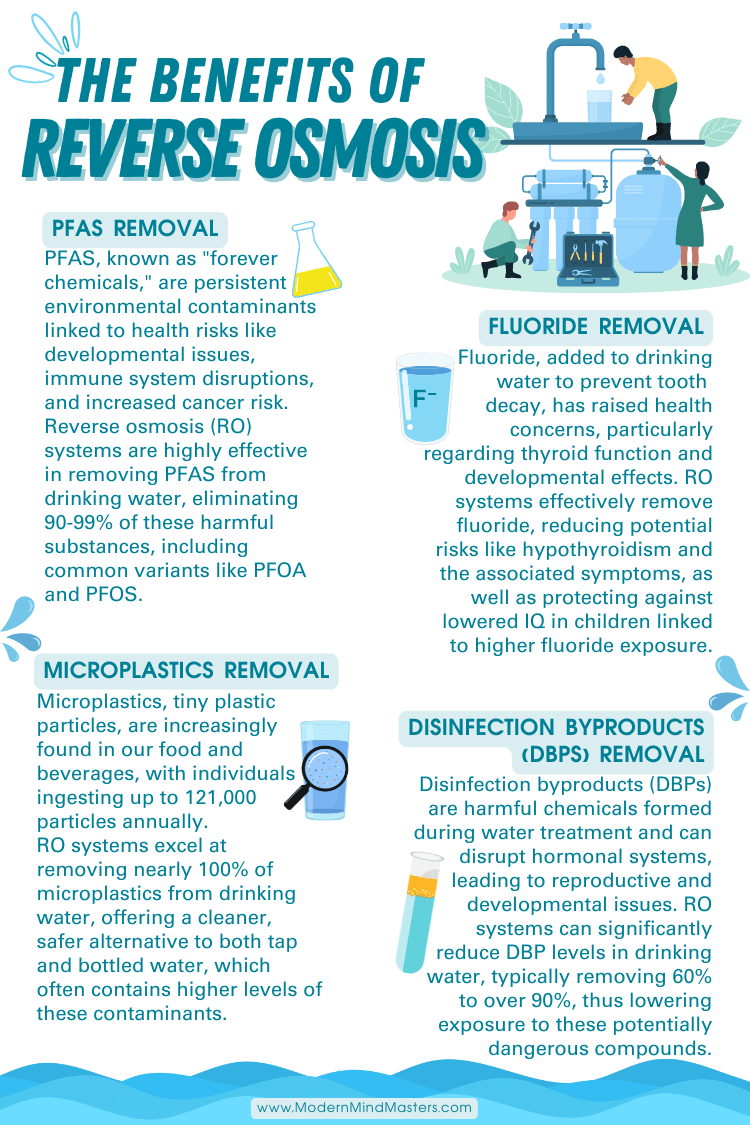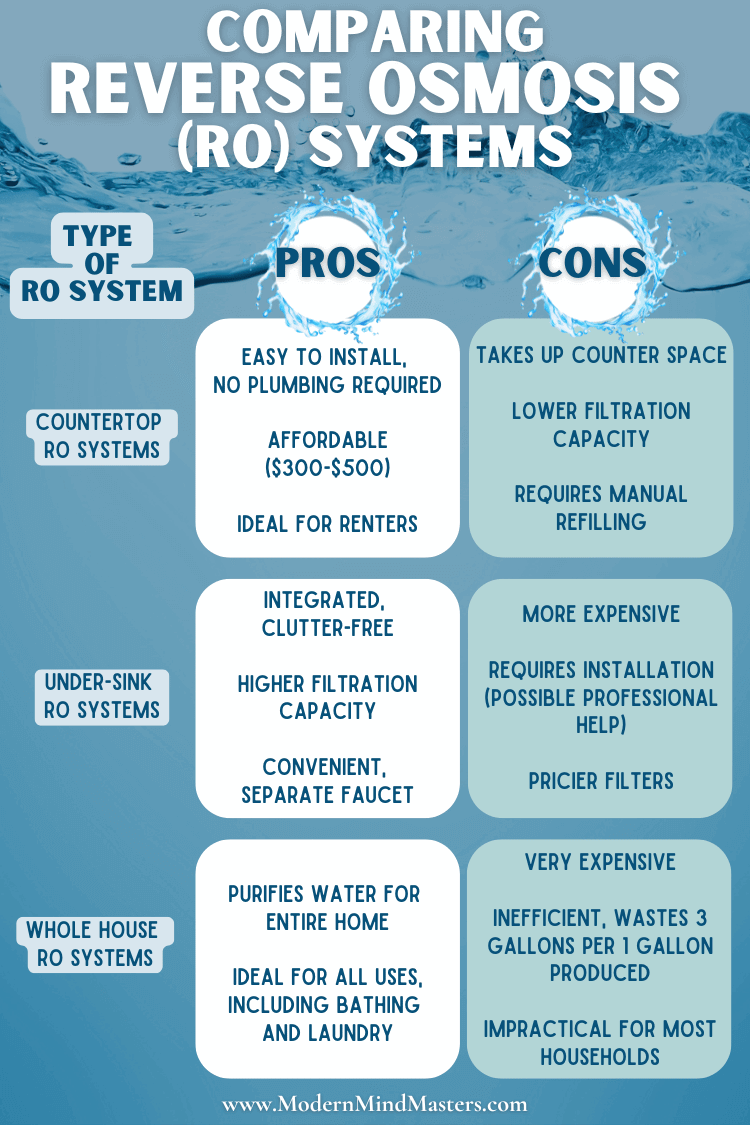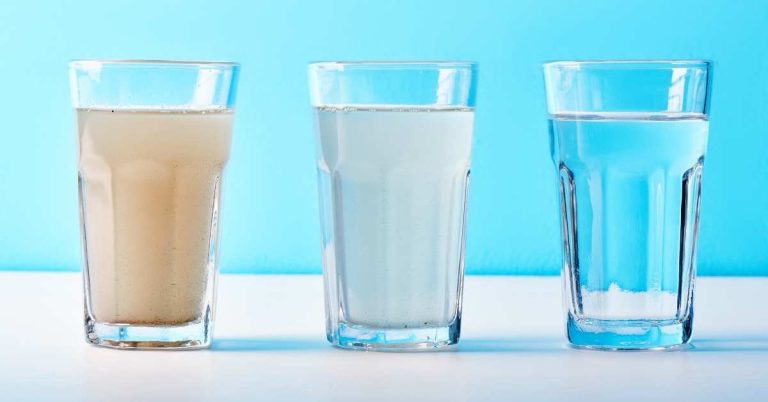Our site features affiliate links. If you buy through them, we earn a commission at no extra cost to you. Thanks for your support!
While tap water in most of the developed world has been considered safe to drink for decades, water filtration systems, from the basic activated carbon filters to the more high-tech reverse osmosis systems, are becoming increasingly common as consumers become more aware of their health.
While doctors and scientists will tell you tap water is perfectly safe, more and more independent research is revealing contrary evidence, suggesting that even fluoride, put into tap water in the mid-1940s for better tooth health, leads to cognitive decline in children, with no safe level identified.
Out of all the water filtration systems available, reverse osmosis (RO) proves to be the gold standard for water filtration, with flexible systems ranging from countertop models to whole-house systems.
This article will cover everything you need to know about reverse osmosis water filtration systems, the pros and cons, and why you would benefit from incorporating such a system into your household.
What are Reverse Osmosis Filtration Systems?
Reverse osmosis (RO) systems are simply a series of very clever filters.
The process begins with pre-filtration, where water passes through a filter (usually carbon-based) to remove larger particles like sediment, dirt, and chlorine, protecting the more delicate parts of the system.
Next, the water is forced through a semipermeable membrane, which is the core of the RO process. This membrane has tiny pores that allow only water molecules to pass through, effectively blocking out contaminants like salts, bacteria, and heavy metals.
After this, the water typically goes through a post-filtration stage, where it might be treated with a carbon filter to remove any remaining tastes or odors. The resulting clean water is then stored in a tank, ready to use. More sophisticated systems may have additional cleaning stages, such as UV, to ensure the water is as fresh as can be.
The term “reverse” describes the rejection water that is reversed from the filter. Good water moves through the unit and is then stored in the tank with the bad water reversed and either stored in a wastewater tank or piped straight into the drain.
One of the major complaints of RO systems is that they can create a lot of wastewater, for those concerned about such things. Typically, for every gallon of purified water produced, an RO system can reject or waste anywhere from 3 to 4 gallons of water. This means that the water waste ratio is generally around 3:1 to 4:1.
For most, however, this wastewater would be a welcome trade-off for pure drinking water.
What Are the Benefits of Reverse Osmosis Water?
Reverse osmosis is one of the most effective ways to remove many contaminants in tap water, such as disinfectant byproducts (DPBs), fluoride, microplastics, and PFAS, as well as harmful viruses and bacteria if any are present.
Even innocent products, like sunscreen, end up leaching harmful chemicals like Even innocent products, like sunscreen, end up leaching harmful chemicals like oxybenzone, octinoxate, and octocrylene — compounds that wash off our skin, enter wastewater, and persist in the environment. These same UV filters have been detected in rivers, drinking water, and even human blood — a reminder that what we put on our bodies can ultimately find its way into them.

Can Reverse Osmosis Remove PFAS?
Given that PFAS (per- and poly-fluoroalkyl substances) are extraordinarily resistant to breaking down and can persist in the environment (and your body) for decades, their presence in drinking water is a pressing issue.
Reverse osmosis is widely recognized as one of the most effective methods for removing PFAS, the notorious “forever chemicals,” from drinking water. These chemicals, known for their persistence in the environment and potential to cause serious health issues such as developmental problems in children, metabolic disorders, immune system disruptions, and an increased risk of cancers, have become a significant concern for both private and public water supplies.
This study, for example, showed that PFAS were detected in about 45% of the drinking water samples, with PFBS, PFHxS, and PFOA being the most common culprits, showing up in roughly 15% of samples.
Studies have shown that reverse osmosis can remove between 90-99% of PFAS (depending on the sophistication of the RO filter), including the most common and concerning variants like PFOA and PFOS, from water sources.
Can Reverse Osmosis Remove Microplastics?
While the advent of flexible, durable, and cheap plastics has helped tremendously in many aspects such as medical advances and food preservation, the resulting tiny plastic particles are broken down by environmental factors like UV radiation, wind, and ocean currents and end up in our watercourses.
Microplastics have become a pervasive presence in the foods and beverages we consume, with the average person ingesting an estimated 39,000 to 52,000 microplastic particles each year through their diet alone. When factoring in the microplastics we inhale from the air, this number can increase dramatically, reaching between 74,000 and 121,000 particles annually.
Fortunately, reverse osmosis has been shown to remove nearly 100% of microplastics, since they are a relatively large molecule and easy to remove.
As a side note for those who drink bottled water to mitigate poor tap water quality: studies reveal that bottled water tends to contain more microplastics than tap water, particularly in products packaged in recycled PET (R-PET) and glass bottles. At what point microplastics are worse than the other contaminants of poor-quality tap water is anyone’s guess, but the only surefire way to avoid both issues is to filter your tap water using RO.
Can Reverse Osmosis Remove Fluoride?
Fluoride has been added to public drinking water since the mid-1940s, based on early research indicating its effectiveness in preventing tooth decay. Known as water fluoridation, this process does appear to have been successful in reducing cavities in both children and adults.
However, in recent decades, a growing body of research suggests that fluoride may pose significant health risks, particularly concerning the thyroid hormone system, which is crucial for various bodily functions, including metabolism, energy levels, and mood regulation.
Disruption of the thyroid can lead to conditions like hypothyroidism, characterized by symptoms such as fatigue, low energy, and mood disturbances, which can exacerbate or mimic depression. A 2018 study found that fluoride, even at concentrations considered safe in tap water (0.5mg/L), can negatively impact thyroid-stimulating hormone (TSH) and T3 hormone levels, potentially contributing to thyroid dysfunction in both healthy individuals and those with pre-existing thyroid conditions.
More alarmingly, a comprehensive six-year review by the National Toxicology Program (NTP) highlighted fluoride’s impact on the developing brain. The review, initially suppressed but later released by court order, revealed that 52 out of 55 studies showed a link between higher fluoride exposure and lower IQ in children.
The review also found no safe threshold for fluoride exposure, raising serious concerns about the continued use of fluoride in public water supplies. Despite these findings, many institutions responsible for regulating fluoride have yet to incorporate this critical information into their guidelines or policies and continue to endorse fluoride use as if these risks were nonexistent.
Can Reverse Osmosis Remove DPBs?
A 2020 study examined water from various global sources, focusing on disinfection byproducts (DBPs) that result from the use of disinfectants like chlorine, chloramines, and ozone in water treatment.
While these disinfectants are intended to make water safe, the study revealed that DBPs can cause endocrine disruption, leading to significant health issues such as reproductive, developmental, and metabolic problems.
The review found that even low concentrations of DBPs in drinking water can disrupt ovarian function, spermatogenesis, and fertility. Additionally, DBPs were linked to adverse reproductive outcomes like reduced fertility, developmental abnormalities, and hormonal disruptions.
While the exact percentage of DBP removal can vary depending on the specific RO system and the types of DBPs present, studies generally show that reverse osmosis systems can remove a significant portion of DBPs, typically ranging from 60% to over 90%.
Is Reverse Osmosis Water Safe?
Since reverse osmosis removes almost everything from water, good and bad, some question whether removing healthy minerals, such as potassium and calcium, might prove detrimental.
I don’t know where these myths started, but they seem to link back to old WHO studies that are now outdated.
The main complaint about RO water is the removal of minerals that the body needs to function properly, such as magnesium, potassium, iron, zinc, and calcium. Some go further by saying that, because RO water is highly pure, it has a high capacity to dissolve substances when it comes into contact with them.
Hence, RO water is sometimes referred to as the “universal solvent”, making it more chemically “hungry” by absorbing minerals, salts, and other substances from its surroundings, including your body. Some claim that this solvent-like property will strip your body of its minerals, causing you to become deficient in these minerals.
There is zero data to back this up, and with a little math, it becomes clear that there is also little logic here. Humans get their minerals mostly from sources other than water, with water contributing a tiny amount. Let’s look at an example using an average male like myself:
Magnesium: An adult man needs 400 mg/day. My drinking water contains less than 0.5 mg/L. To meet my daily magnesium requirement, I’d have to drink 800 liters of water. Or, I could just have a bowl of oatmeal and a handful of peanuts.
Iron: The daily requirement for an adult man is 8 mg. My water would require me to drink 133 liters to hit that target. Or, I could eat 6 ounces of meat.
Potassium: An adult man needs 3,400 mg/day. With an average of 2.5 mg/L in water, I’d need to drink 1,300 liters to get enough. For reference, drinking 6L of water in three hours has been known to kill.
Zinc: The daily requirement is 11 mg. To get that from my water, I’d have to drink 110 liters. Or, I could just eat a single portion of meat and be halfway there.
Calcium: An adult man needs 1,000 mg/day. My water would require me to drink 1,000 liters to meet that. Even with the average calcium content of water in the U.S., you’d still need to consume 250 liters. Eat some seeds or cheese instead.
As we can see, water makes up an insignificant amount of minerals for the average daily allowance, with the vast majority coming from food. For anyone with a halfway healthy diet, they will be more than fine.
Do I Need to Remineralize RO Water?
Because of the widespread myth that RO water is void of minerals that the body needs, and that it might strip your body of these important minerals, some advocate for remineralizing RO water after it has been treated to add such minerals back into the water.
Since the contribution of minerals from water to your daily recommended allowances of minerals is near negligible, so is the effect of remineralizing RO water.
The only genuine benefit of remineralization is that, since RO water is very pure, it can taste flat or empty to some who are used to drinking mineralized water. It’s not that RO water tastes bad – it technically doesn’t taste of anything since there are no minerals in it – it’s just that some prefer the taste of water with minerals.
Personally, I prefer the taste of purer water, but you can remineralize if you prefer the taste. If you do wish to remineralize, ensure you buy them from a reputable source – since there is no governing body for minerals, you’ll never know exactly what is in them.
Types of Reverse Osmosis Systems
Understanding the need for RO systems is only half the battle, finding a good quality system, within your budget, that fulfills your water needs is a different challenge.
The various types of RO systems broadly fall under three categories: countertop systems, under-sink systems, and whole-house systems.

Countertop RO Systems
Countertop RO systems are the easiest systems to install, offering a plug-and-go system that does not require any plumbing or DIY to install. You simply plug in the appliance, fill the water tank with regular tap water, and enjoy your clean and refreshing RO water.
Since they don’t require drilling or plumbing alterations, countertop systems are a good option for those who prefer not to make permanent changes to their kitchens, such as those who rent. Generally, they are cheaper than the other systems, costing between $300-500 for a good quality model. The filters also need to be replaced every 6-12 months, depending on your model and consumption, which will run you around $100.
As the name suggests, countertop systems take up space on your kitchen counter, which might be a drawback in smaller kitchens or those wishing for a minimalist “clutter-free” countertop. They also generally have a lower filtration capacity, meaning they produce smaller amounts of purified water, which might not be sufficient for larger households. While some models can be plumbed in, most require a water tank to be manually refilled.
Under-Sink RO Systems
If your budget and living conditions allow, under-sink RO systems provide the most convenient access to reverse osmosis filtered water, although they are usually more expensive to buy and require greater effort to install.
Installed under the sink, these systems are out of sight, saving counter space and keeping your kitchen looking clean and uncluttered. On the other hand, these systems require more complex installation, including drilling and plumbing work. Professional installation might be necessary for those not wanting to do the fairly easy installation, adding to the cost.
These systems come with a separate faucet for dispensing purified water, avoiding the need to modify your existing faucets. While less expensive than whole-house systems, under-sink systems are generally pricier than countertop options, including the filters that must be purchased every 6-12 months.
Whole House RO Systems
For those looking for the most premium setup, whole house RO systems provide purified water to every faucet, showerhead, and appliance in the home, ensuring high-quality water for all uses, including bathing and laundry.
For some, such as those with sensitive skin conditions, RO water for showering and bathing may help, but for the vast majority, whole house systems are expensive and inefficient.
Modern RO systems typically waste 3 gallons of water for every one gallon of freshwater produced, which is not a big deal for small-scale drinking water setups, but adds up to a lot of wastewater that most will pay for when filtering an entire household worth of water. That’s money you’re literally flushing down the toilet.
Whole house systems are a viable option only for a small percentage of people; for the vast majority, under-sink or countertop models are more than enough to obtain perfectly fine drinking water.
Final Thoughts
For the vast majority who simply want to treat their tap water effectively to a point where they no longer have to worry about it, reverse osmosis water filtration systems will tick all boxes at a reasonable price.
Whereas other water treatment options offer different circumstantial benefits, RO systems combine multiple filtration technologies into one simple-to-use product.
Not all RO systems are equal, however. I would certainly recommend a well-known and reputable brand (I use the Waterdrop K19 with no issues), and shy away from cheaper untested models. Don’t forget you’ll need to purchase replacement filters periodically, so price this into your budget when considering options for different models.
Whether you go for a countertop or under-sink model depends on your budget and appetite for DIY, so you’ll have to do a little research to find the best fit for you. The effort is worth it, however; no price can be put on clean and healthy water.
FAQs
Is it healthy to drink reverse osmosis water?
Reverse osmosis is one of the most effective ways to remove many contaminants in tap water, such as disinfectant byproducts (DPBs), fluoride, microplastics, and PFAS, as well as harmful viruses and bacteria if any are present.
What is the disadvantage of reverse osmosis water?
One of the major complaints of RO systems is that they can create a lot of wastewater, for those concerned about such things. Typically, for every gallon of purified water produced, an RO system can reject or waste anywhere from 3 to 4 gallons of water. This means that the water waste ratio is generally around 3:1 to 4:1.
Should you add minerals to reverse osmosis water?
Since the contribution of minerals from water to your daily recommended allowances of minerals is near negligible, so is the effect of remineralizing RO water.
The only genuine benefit of remineralization is that, since RO water is very pure, it can taste flat or empty to some who are used to drinking mineralized water. It’s not that RO water tastes bad – it technically doesn’t taste of anything since there are no minerals in it – it’s just that some prefer the taste of water with minerals.






